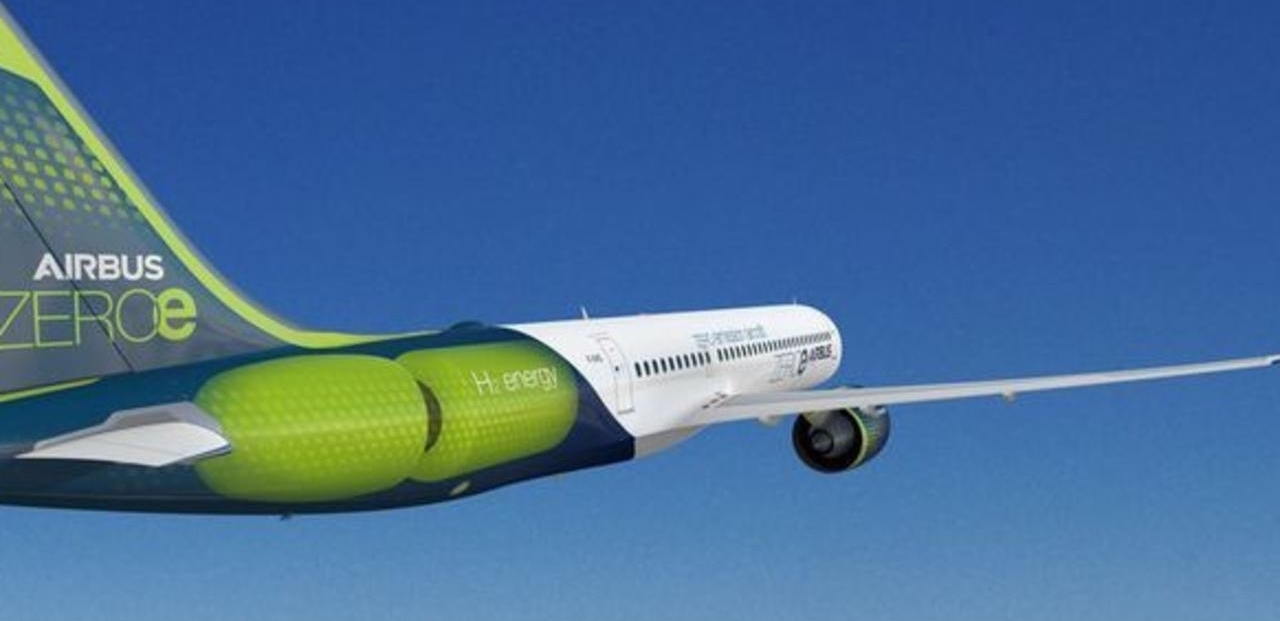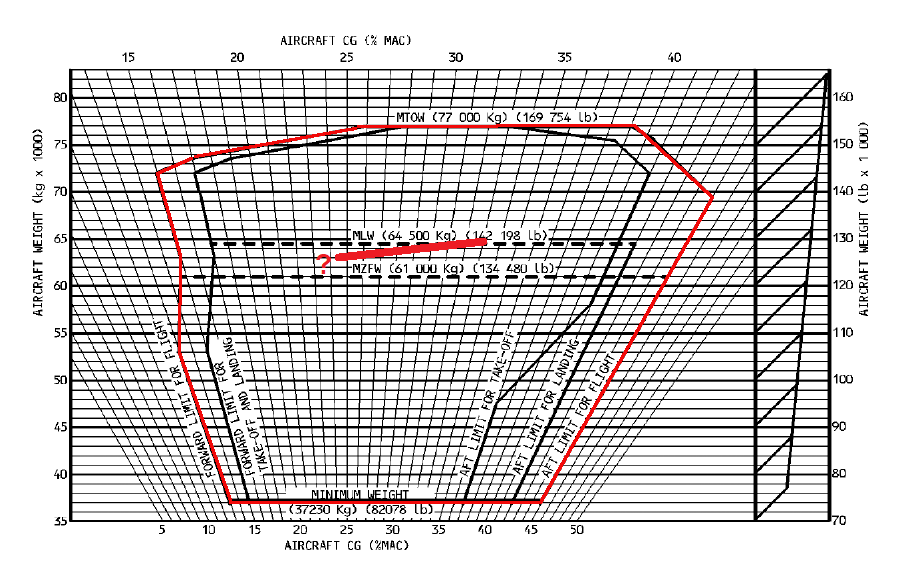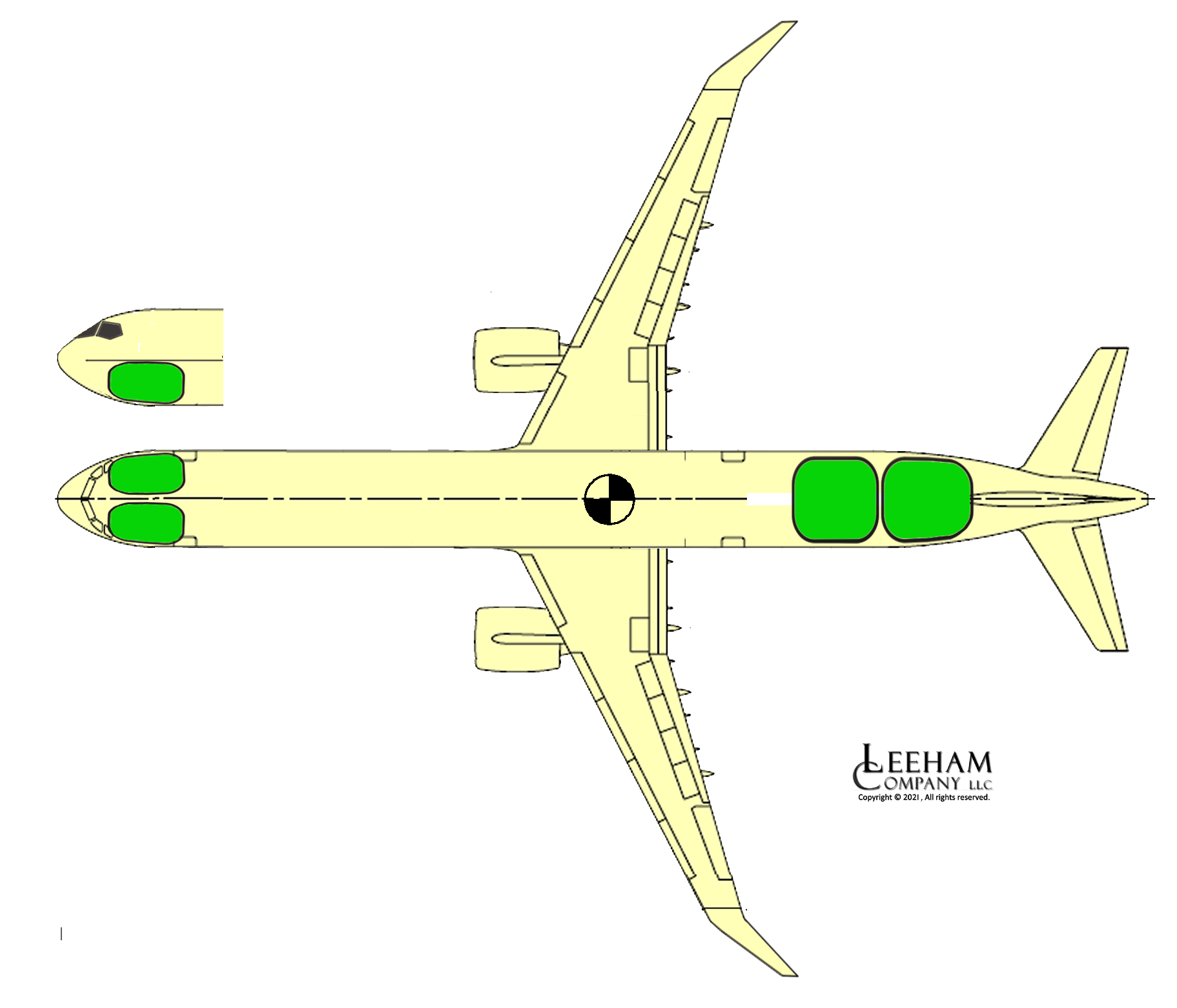Leeham News and Analysis
There's more to real news than a news release.
Bjorn’s Corner: The challenges of hydrogen. Part 21. Hydrogen airliner weight shift
January 22, 2021, ©. Leeham News: In last week’s Corner, we looked at how the hydrogen consumed in the rear fuselage tanks changes the airliner’s Center of Gravity (CG).
Now we discuss how this change of Center of Gravity, limiting the aircraft’s load flexibility, can be mitigated with different concepts.
How to mitigate a rear tank installation’s CG change
The Airbus ZEROe turbofan airliner concept in Figure 1 has two tanks placed in the rear, Figure 2. The rear placement is to not divide the cabin into two compartments with difficulty getting access to the front part of the aircraft, which would be the consequence of a full size front and rear tank setup.
But the drawback of the rear placement is CG shifts with up to 17% of the mean aerodynamic chord, Figure 3.
This is limiting the load flexibility of the aircraft. What can we do to limit this shift of CG?
Several Airbus aircraft types (A330, A340, A380) use tailplane fuel trim tanks to achieve an optimal CG change during a flight.
Can this be used for an airliner like the ZEROe? Yes, it can.
The Liquid Hydrogen (LH2) tanks of an airliner are less flexible in their form as they, for cryogenic isolation reasons, are cylindrical or tubular in design.
The ideal placement of LH2 trim tanks would be as far forward as possible. Liquid hydrogen then flows to the rear tanks as LH2 gets consumed in these.
Shifting masses around
In the last Corner, there were several ideas of how we could shift masses around in the aircraft to compensate for the CG shift. One idea was to put the freshwater tank upfront and the wastewater tank in the rear.
When passengers visited the lavatory, gradually the CG of the water system shifted back. It’s a good idea, but the mass of water on a domestic airliner is around 1kg per passenger, so we would have ~150kg to shift around.
The most efficient idea is if we can distribute the fuel of the aircraft without ending up blocking the passageways in the cabin. A design that is similar to the water one is shown in Figure 4.
Here the total fuel load of 4.1t is divided between two “cheek” tanks in the front, below the cockpit floor, and rear tanks. The distance to the front tanks is twice the average distance of the rear tanks, so if we could store 1/3 of our fuel upfront, we could get a balanced system.
Today, the space under the cockpit floor is used as an avionics compartment and for the nose landing gear bay. The nose landing gear has moved forward to under the weather radar for the A380 and A350 as this is structurally more efficient, and the avionics could move to the crown of the cockpit or into the compartments on the sides of the front cargo bay. This allows us to use the space below the cockpit floor for the tanks.
Modern airliners (Boeing 787, MC-21, C919) have more blunt nose profiles as this is more structurally efficient without compromising the aerodynamic efficiency. Modern CFD allows the designers to shape the nose so no supersonic pockets are created around a plump nose profile. The blunter nose gives more volume for the tanks and the repartitioned avionics compartments.
Such a split fuel system is a bit heavier than the original design, but it would fix the CG displacement problem and the efficiency loss due to a nose-heavy aircraft at the end of the flight.
The problem of how to store the LH2 in a hydrogen airliner is an area crying for innovation. We have discussed a couple of concepts; numerous others await discovery and presentation.







Bjorn what about putting cylindrical or tubular tanks under the floor and baggage at the rear (like a turboprop) on the main deck using same containers as freighters with a big freight door? Potentially could improve turnaround time relative to bulk loading of the hold (B737) or multiple small cans (A321).
The surface area on the underfloor tanks would increase relative to the volume contained, which would increase heat transfer into the tanks. And crashworthiness would be a consideration, with protection of passengers from cryogenic fluid for a tank rupture on impact. The aft fuselage placement is optimal for both of these storage aspects.
There isn’t a weight-free solution to the trim problem. As Bjorn pointed out last week, the efficiency penalty for accepting the imbalance is not large. Retaining about 5% of the condensed combustion H2O, in a tail tank, would also do the trick. But would result in much less loss of mass during the flight. So again would result in a small loss of efficiency.
I just wonder how much additional boil-off loss of LH2 any additional meter of cryogenic fuel line implies! It is “expensive” to run fuel lines through the pressured passenger cabin. –> Needs to be fail-save and well isolated.
Only in the tanks is LH2.
In the fuel lines is H2 which will be burnt in the engines soon.
The ‘cheek tank’ idea is interesting, but unfortunately they would be very vulnerable to particular risks such as tyre burst or bird strike.
One way to solve the piping is to route them outside of the pressure shell in fairings with minimal vent holes outside of the pressure shell.
I’m not sure what volume would be required for e.g. 2 hr /1000NM flights. But having tanks spread out to manage CG and too have them easily removable for inspections could be a plus.
Spreading them out and use the less useful space beneath deck, use smaller, lighter tanks and leave some structure below for crash requirements could be viable. Space would remain available lower deck for luggage containers. Maybe existing AKH’s sideways. E.g. freshwater could be kept in wing tanks.
https://groups.google.com/group/aviation_innovation/attach/18293db3ce7cc/Hydrogen%20airliner%20tank%20configuration.jpg?part=0.1&view=1
One of the main issues to consider here is the engine turbine burst. For a typical tube-with-wings with large bypass turbofans, the risk area is roughly between doors 1 and the main gear bay. As turbine fragments are considered infinite energy, the structure cannot be considered as a “shield”, so all system components in this area must be able to fail without impacting critical functions.
So installing critical avionics in this area is not a great idea, and putting any sub-part of the fuel system (let alone the tanks themselves) is going to create some nasty ripple effects on the overall systems design.
Also, moving fluids around the aircraft should be avoided as much as possible. Apart from the extra weight of pipes and pumps, it creates extra possibilities of leaks and failures, and thus dispatch and maintenance issues. Moving sh#t around is a typical reflex of designers that never survives the first encounter with a real-world mechanic who will need to remove and replace the sh#t pumps…
Before considering those things, I’d go back to the problem. From your previous posts, we’re looking at 0,5%-1,5% efficiency loss due to 1,5-3tons of weight variation, **all the rest of the aircraft being equal**.
The latter part deserves some attention. If weight can be concentrated near the CoG of the aircraft, the relative impact of those 1,5-3 tons could be reduced somewhat.
This would be a more electric aircraft with heavy power electronics and auxiliary power fuel cells, all with cooling and shelves etc…. All these things could installed in the location of the now empty center wing tank. We could potentially add with some good old heavy ARIC600 avionics boxes (maybe in 15 years we’ll be looking at more distributed networks of hundreds of smartphone-like nodes…who knows). The empty space in the nose could become the bulk cargo compartment, which could be used for removable ballast if really necessary on some corner-case missions.
Water waste tanks could be located in the center area too (wing roots ?). The landing gear could be adjusted as well, now that everything else is moved. And the wings are dry, so maybe something could be done inside them as well. Perhaps the relatively small hydrogen reserve tanks could be located there (and be on the main path from the tanks to the engines, so no added piping required).
So it could be interesting to check the sensitivity of the efficiency loss vs the weight distribution. In the end, considering that and Adaptive Dropped Hinge Flaps as well, the net loss of efficiency is too small to justify any complicated trim system.
Some details need more explanation, the idea was to move the fresh water from forward tanks to the toilets and then to a rear holding tank. This happens now anyway just the holding tanks for freshwater and waste are better located for weight shifting. Planes have these features so there must be pipes connecting toilets and holding tanks. Its not a new issue to do this.
The avionics could be above the forward cabin – and other locations for redundancy which addressees the engine turbine fragments problem
On the general subject of using hydrogen fuel as an energy storage medium:
CNBC: “Hydrogen is going to take 25% of all oil demand by 2050, Bank of America analyst says”
“The EU has laid out plans to install 40 gigawatts of renewable hydrogen electrolyzers and produce as much as 10 million metric tons of renewable hydrogen by the year 2030.”
https://www.cnbc.com/2021/01/22/hydrogen-will-take-25percent-of-oil-demand-by-2050-bank-of-america-analyst.html
Doubt there is any real plans to do so, its all ‘bold claims’
6 months ago it was this :
“The European Commission wants the EU to install at least 6 GW of electrolyzer capacity able to produce up to 1 million mt of renewable hydrogen by 2024”
The EU is just a talk shop, they arent even adressing the new energy build to massively reduce the existing fuel sources such as coal, let alone natural gas Its a sign of inaction when even bigger claims are made …always further out
Getting coal rich Poland to shut their power plants, some the awful lignite, and the money they make exporting power to their central european neighbours will be a big task in itself
one of the great benefits of non-cryogenic, non-pressurized liquid fuels is that you _can_ store them just about anywhere you can seal, which greatly improves the overall structural and volumetric efficiency of the airplane.
what are the structural, volumetric and skin drag penalties of putting 100% of fuel system weight and volume in the fuselage? (which including tanks and insulation and extra piping is a 100% added weight to the system vice kerosene tankage which is largely just using existing otherwise empty space between structural members and requires no special structural or insulation properties)
your wing and wingbox are going to have to be significantly stronger since none of the fuel weight is carried in the wings….
Boeing’s answer to greener aviation:
Reuters: “Boeing says its fleet will be able to fly on 100% biofuel by 2030”
https://www.reuters.com/article/us-boeing-biofuels/boeing-says-its-fleet-will-be-able-to-fly-on-100-biofuel-by-2030-idUSKBN29R2C4
So they have no plan. Not surprising from Boeing. All Boeing planes could fly on biofuel in 1930 with some small adjustments to the engine. Problem is not that you can’t make it work because that is relatively easy but that the supply of biofuels is to limited
Isn’t Hydrogen Explosive?
Hindenburg incident.
You want to build another flying machine carrying Liquid Hydrogen??
Bad idea.
Not explosive unless it is premixed with the right amount of air or oxygen.
Oh dear . Read through all the previous posts on the challenges of hydrogen- this is part 21
https://leehamnews.com/tag/hydrogen-aircraft/
And no the Hindenberg didnt have liquid hydrogen…there you have learnt something already
Bjorn
You wrote that without the cheek tanks there was 0,5%-1,5% efficiency loss due to the 1,5-3tons of weight variation.
The cheek tanks are to address that but to what degree? There is now some fixed additional weight (as well as complexity) which will cost some efficiency. What is your estimate of that cost? Or do you feel it is too small to be reliably calculated?
https://leehamnews.com/tag/hydrogen-aircraft/
See what Bjorn has covered in previous posts
Of interest to the Airbus hydrogen initiatives, this (French-language) link was posted yesterday by Gerrard White in another item here on LNA. Airbus has filed for a patent application for removable/exchangeable underwing pods, each of which is a self-contained combination of hydrogen tank + fuel cell + motor + propellor. It is explicitly indicated in the text that such an approach frees up space in the fuselage.
Most patent applications filed by companies never materialize into an actual product, but this concept is interesting.
The second link provides a short English synopsis.
https://www.capital.fr/entreprises-marches/hydrogene-airbus-depose-un-brevet-1391690
https://www.energylivenews.com/2021/01/04/airbus-unveils-design-for-detachable-hydrogen-fuel-cell-wing-pods-for-zero-emission-flights/
It would add a lot of weight to the wings, wingfuel tanks would no longer be required. And then there is dynamics, flutter. So it would results in entirely different wing designs than we are used too. Back to the CFD models and windunnels.
I guess those tanks would have to be bullet proof. If they are a few hundreds bar they empty, H2 spreads around, mix, rather quickly I imagine.
On the Airbus removable pod concept, there’s also an item on the Airbus website:
https://www.airbus.com/newsroom/stories/hydrogen-pod-configuration.html
It’s not really worthy of a patent even if it is a good idea.